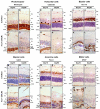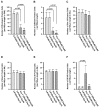Intravitreal homocysteine-thiolactone injection leads to the degeneration of multiple retinal cells, including photoreceptors
- PMID: 21850169
- PMCID: PMC3156793
Intravitreal homocysteine-thiolactone injection leads to the degeneration of multiple retinal cells, including photoreceptors
Abstract
Purpose: Hyperhomocysteinemia is known to cause degeneration of retinal ganglion cells, but its influence on photoreceptors remains largely unknown. In particular, the role of homocysteine-thiolactone (Hcy-T)--the physiologic metabolite of homocysteine that has been proven to be more cytotoxic than homocysteine itself--as a factor that causes retinopathy, has not been defined. This study aimed to investigate the toxic effects of excessive Hcy-T in a mouse model.
Methods: A total of 60 six-week-old female ICR mice were used in this study. The mice were divided into 3 experimental groups and 2 control groups. The mice in the experimental groups were subjected to intravitreal injections of Hcy-T to reach final estimated intravitreal concentrations at 5, 25, and 200 μM, respectively. Mice without injection (blank) and with 0.9 NaCl injections (sham injection) were used as controls. The mice with 200 μM Hcy-T were sacrificed at days 7, 15, 45, and 90 after injection and the mice with 5 or 25 μM Hcy-T were sacrificed at day 90, with the controls sacrificed at day 15 or 90 for comparison. Semi-quantitative dot-blot analysis was performed for confirmation of retinal homocysteinylation. The mouse retinas were evaluated microscopically, with the thickness of total and specific retinal layers determined. Immunohistochemical analysis was performed and the labeled cells were quantified to determine the effects of excessive Hcy-T on specific retinal cells.
Results: Dose-dependent retinal homocysteinylation after Hcy-T injection was confirmed. The homocysteinylation was localized in the outer and inner segments of photoreceptors and the ganglion cell layer (GCL). Retinal cell degenerations were found in the GCL, inner nuclear layer, and outer nuclear layer at day 90 after 200 µM Hcy-T injection. Significant thickness reduction was found in the total retina, outer nuclear layer, and the outer and inner segment layers. A trend of thickness reduction was also found in the GCL and inner nuclear layer, although this was not statistically significant. The rhodopsin⁺ photoreceptors and the calbindin⁺ horizontal cells were significantly reduced at day 15, and were nearly ablated at day 90 after 200 μM Hcy-T injection (p<0.001 for both day 15 and day 90), which was not seen in the sham injection controls. The Chx-10⁺ or the Islet-1⁺ bipolar cells and the Pax-6⁺ amacrine cells were severely misarranged at day 90, but no significant reduction was found for both cell types. The GFAP⁺ Müller cells were activated at day 15, but were not significantly increased at day 90 after the injection.
Conclusions: Excessive retinal homocysteinylation by Hcy-T, a condition of hyperhomocysteinemia, could lead to degeneration of photoreceptors, which might lead to retinopathies associated with severe hyperhomocysteinemia or diabetes mellitus.
Figures





References
-
- Perla-Kaján J, Twardowski T, Jakubowski H. Mechanisms of homocysteine toxicity in humans. Amino Acids. 2007;32:561–72. - PubMed
-
- Karolczak K, Olas B. Mechanism of action of homocysteine and its thiolactone in hemostasis system. Physiol Res. 2009;58:623–33. - PubMed
-
- Dionisio N, Jardin I, Salido GM, Rosado JA. Homocysteine, intracellular signaling and thrombotic disorders. Curr Med Chem. 2010;17:3109–19. - PubMed
Publication types
MeSH terms
Substances
LinkOut - more resources
Full Text Sources
Miscellaneous
